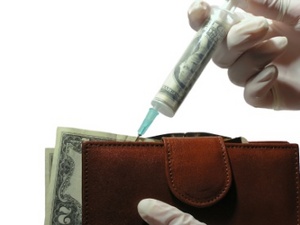
|
| ©Unknown |
Tight budgets affect almost everyone at home and in the workplace. But when does a tight budget at a university invite corporate conflicts of interest that potentially taint professors and their curriculum?
The American Medical Student Association (AMSA) has issued a scorecard on conflicts of interest by pharmaceutical companies on universities across the country.
The research finds most of the 150 medical schools in the U.S. are failing when it comes to erecting conflict of interest policies that ensure pharmaceutical marketing cannot take hold on campus.
The pharmaceutical industry spends large sums of money to market to doctors about drugs, an amount estimated to be about $28 to $46 billion a year.
AMSA represents physicians-in-training. For this project, the group collaborated with The Prescription Project, funded by the Pew Charitable Trust.
The goal of the Prescription Project is to avoid compromises in patient care resulting from conflicts of interest that erode public confidence in the medical profession.
"The schools that earned 'A' and 'B' scores are to be commended for setting a high bar and aggressively moving forward to ensure medical education, training and patient care is free of commercial bias," says RxP executive director Robert Restuccia in a statement.
"While we still have a long way to go, we are optimistic that the growing momentum for reform will change the landscape and there will be great improvement next year."
Conflict of interest is defined by 11 different criteria: whether the school has a policy on accepting gifts and meals; whether consulting relationships are allowed as well as industry-funded speaking, both on and off campus.
The AMSA grades on whether faculty is required to disclose potential conflicts of interest to supervisors on a regular basis; and on whether they can accept pharmaceutical samples. They also gauge whether there are industry-sponsored scholarships and funds.
A conflict is also defined as adjusting the medical school curriculum to reflect the marketing of pharmaceuticals. Schools are judged on whether there is oversight to prevent such things. Lastly, AMSA asked whether there were explicit sanctions for noncompliance with school policies against conflicts of interest.
Seven schools go to the head of the class, graded with words like "exemplary", "model", and "a complete ban."
They include, University of Pittsburgh Medical Center, Pittsburgh, PA; Mount Sinai School of Medicine, NY; University of California Davis School of Medicine, Sacramento, CA; University of Pennsylvania School of Medicine, Philadelphia, PA; University of California Los Angeles, CA; Uniformed Services University of the Health Sciences, Bethesda, MD.
On the other end of the scale are many universities that didn't respond.
In January, a published study estimated that U.S. pharmaceutical companies spend twice as much marketing drugs as they spend researching new ones.
"The Cost of Pushing Pills: A New Estimate of Pharmaceutical Promotion Expenditures in the United States," estimates that U.S. drug sales amount to about $235.4 billion annually.
That translates to $57.5 billion spent on total promotion by pharmaceutical companies in 2004 or about $61,000 per physician in promotion that year.



Reader Comments
to our Newsletter